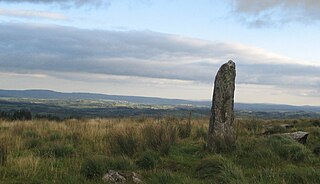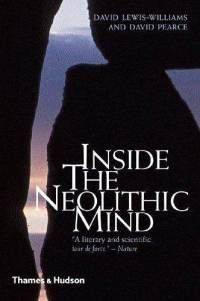Related Research Articles

Andrew Colin Renfrew, Baron Renfrew of Kaimsthorn, is a British archaeologist, paleolinguist and Conservative peer noted for his work on radiocarbon dating, the prehistory of languages, archaeogenetics, neuroarchaeology, and the prevention of looting at archaeological sites.

The Ring of Brodgar is a Neolithic henge and stone circle about 6 miles north-east of Stromness on Mainland, the largest island in Orkney, Scotland. It is part of the UNESCO World Heritage Site known as the Heart of Neolithic Orkney.

A menhir, standing stone, orthostat, or lith is a large upright stone, emplaced in the ground by humans, typically dating from the European middle Bronze Age. They can be found individually as monoliths, or as part of a group of similar stones. Menhirs' size can vary considerably, but they often taper toward the top.

Stuart Ernest Piggott, was a British archaeologist, best known for his work on prehistoric Wessex.

Kit's Coty House or Kit's Coty is a chambered long barrow near the village of Aylesford in the southeastern English county of Kent. Constructed circa 4000 BCE, during the Early Neolithic period of British prehistory, today it survives in a ruined state.
Brian Murray Fagan is a prolific British author of popular archaeology books and a professor emeritus of Anthropology at the University of California, Santa Barbara.
Caroline Ann Tuke Malone is a British academic and archaeologist. She was Professor of Prehistory at Queen's University, Belfast from 2013 and is now emeritus professor.
Steven Mithen, is a Professor of Archaeology at the University of Reading. He has written a number of books, including The Singing Neanderthals and The Prehistory of the Mind: The Cognitive Origins of Art, Religion and Science.

The Tumulus of Bougon or Necropolis of Bougon is a group of five Neolithic barrows located in Bougon near La-Mothe-Saint-Héray, between Exoudon and Pamproux in Nouvelle-Aquitaine, France. Their discovery in 1840 raised great scientific interest. To protect the monuments, the site was acquired by the department of Deux-Sèvres in 1873. Excavations resumed in the late 1960s. The oldest structures of this prehistoric monument date to 4800 BC.
Julian Stewart Thomas is a British archaeologist, publishing on the Neolithic and Bronze Age prehistory of Britain and north-west Europe. Thomas has been vice president of the Royal Anthropological Institute since 2007. He has been Professor of Archaeology at the University of Manchester since 2000, and is former secretary of the World Archaeological Congress. Thomas is perhaps best known as the author of the academic publication Understanding the Neolithic in particular, and for his work with the Stonehenge Riverside Project.

The Neolithic period in the British Isles lasted from c. 4100 to c. 2,500 BCE. Constituting the final stage of the Stone Age in the region, it was preceded by the Mesolithic and followed by the Bronze Age.

The Cambridge Archaeological Journal is a peer-reviewed academic journal for cognitive and symbolic archaeology published by Cambridge University Press on behalf of the McDonald Institute for Archaeological Research. It was established in 1991 and is published triannually. It includes major articles, shorter notes, book reviews, and review articles, especially those related to cognitive archaeology.

Inside the Neolithic Mind: Consciousness, Cosmos and the Realm of the Gods is a cognitive archaeological study of Neolithic religious beliefs in Europe co-written by the archaeologists David Lewis-Williams and David Pearce, both of the University of the Witwatersrand in Johannesburg, South Africa. It was first published by Thames and Hudson in 2005. Following on from Lewis-Williams' earlier work, The Mind in the Cave (2002), the book discusses the role of human cognition in the development of religion and Neolithic art.

Prehistoric art in Scotland is visual art created or found within the modern borders of Scotland, before the departure of the Romans from southern and central Britain in the early fifth century CE, which is usually seen as the beginning of the early historic or Medieval era. There is no clear definition of prehistoric art among scholars and objects that may involve creativity often lack a context that would allow them to be understood.
Paul Barry Pettitt, FSA is a British archaeologist and academic. He specialises in the Palaeolithic era, with particular focus on claims of art and burial practices of the Neanderthals and Pleistocene Homo sapiens, and methods of determining the age of artefacts from this time. Since 2013, he has been Professor of Archaeology at Durham University. He previously taught at Keble College, Oxford and the University of Sheffield.

Shrub's Wood Long Barrow is an unchambered long barrow located near to the village of Elmsted in the south-eastern English county of Kent. It was probably constructed in the fourth millennium BCE, during Britain's Early Neolithic period. Built out of earth, the long barrow consists of a sub-trapezoidal tumulus flanked by side ditches.

Jacket's Field Long Barrow is an unchambered long barrow located near to the village of Boughton Aluph in the south-eastern English county of Kent. It was probably constructed in the fourth millennium BCE, during Britain's Early Neolithic period. Built out of earth, the long barrow consists of a sub-trapezoidal tumulus flanked by side ditches.

Dr Anna Ritchie OBE, BA, PhD, FSA, Hon FSA Scot is a British archaeologist and historian.
References
- 1 2 3 4 "Prof Chris Scarre, MA PhD FSA". Staff. University of Durham. Retrieved 16 July 2013.
- ↑ Barker, Graeme. "Introduction" (PDF). Annual Report 2005–2006. McDonald Institute for Archaeological Research. p. 2. Archived from the original (PDF) on 21 February 2008. Retrieved 16 July 2013.
- 1 2 3 "Chris Scarre, Archaeology". Explorers. National Geographic. Archived from the original on 17 July 2013. Retrieved 16 July 2013.
- ↑ "Chris Scarre". About This Author. Bookish. Archived from the original on 19 December 2013. Retrieved 16 July 2013.
- ↑ "Rare archaeological finds in Herm". BBC News. 3 November 2009. Retrieved 16 July 2013.
- ↑ "Editor – Chris Scarre". Contact. Antiquity. Archived from the original on 20 June 2013. Retrieved 16 July 2013.
- ↑ "Prof Chris Scarre". CBA Trustees. Council for British Archaeology. Archived from the original on 7 March 2013. Retrieved 16 July 2013.
- ↑ "S". List of Fellows. Society of Antiquaries of London. Archived from the original on 4 November 2007. Retrieved 16 July 2013.